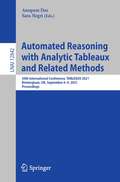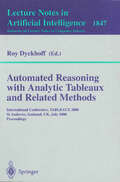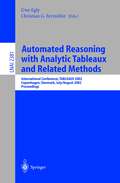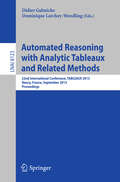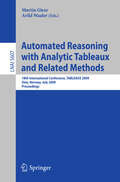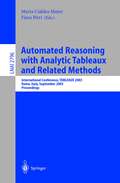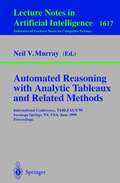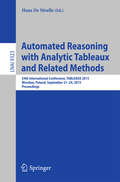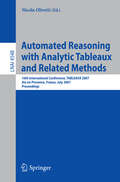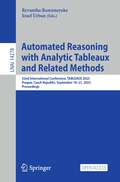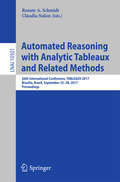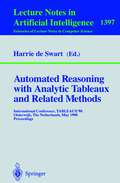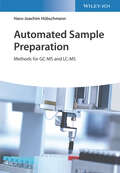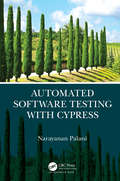- Table View
- List View
Automated Reasoning with Analytic Tableaux and Related Methods: 30th International Conference, TABLEAUX 2021, Birmingham, UK, September 6–9, 2021, Proceedings (Lecture Notes in Computer Science #12842)
by Anupam Das Sara NegriThis book constitutes the proceedings of the 30th International Conference on Automated Reasoning with Analytic Tableaux and Related Methods, TABLEAUX 2021, held in Birmingham, UK, in September 2021.The 23 full papers and 3 system descriptions included in the volume were carefully reviewed and selected from 46 submissions.They present research on all aspects of the mechanization of tableaux-based reasoning and related methods, including theoretical foundations, implementation techniques, systems development and applications. The papers are organized in the following topical sections: tableau calculi, sequent calculi, theorem proving, formalized proofs, non-wellfounded proofs, automated theorem provers, and intuitionistic modal logics.
Automated Reasoning with Analytic Tableaux and Related Methods: International Conference, TABLEAUX 2000 St Andrews, Scotland, UK, July 3-7, 2000 Proceedings (Lecture Notes in Computer Science #1847)
by Roy DyckhoffAutomated Reasoning with Analytic Tableaux and Related Methods: International Conference, TABLEAUX 2002. Copenhagen, Denmark, July 30 - August 1, 2002. Proceedings (Lecture Notes in Computer Science #2381)
by Uwe Egly Christian G. FernmüllerAutomated Reasoning with Analytic Tableaux and Related Methods: 22nd International Conference, TABLEAUX 2013, Nancy, France, September 16-19, 2013, Proceedings (Lecture Notes in Computer Science #8123)
by Didier Galmiche Dominique Larchey-WendlingThis book constitutes the refereed proceedings of the 22th International Conference on Automated Reasoning with Analytic Tableaux and Related Methods, TABLEAUX 2013, held in Nancy, France, in September 2013. The 20 revised research papers presented together with 4 system descriptions were carefully reviewed and selected from 38 submissions. The papers cover many topics as proof-theory in classical and non-classical logics, analytic tableaux for various logics, related techniques and concepts, e.g., model checking and BDDs, related methods (model elimination, sequent calculi, resolution, and connection method), new calculi and methods for theorem proving and verification in classical and non-classical logics, systems, tools, implementations and applications as well as automated deduction and formal methods applied to logic, mathematics, software development, protocol verification, and security.
Automated Reasoning with Analytic Tableaux and Related Methods: 18th International Conference, TABLEAUX 2009, Oslo, Norway, July 6-10, 2009, Proceedings (Lecture Notes in Computer Science #5607)
by Martin Giese Arild WaalerThis volume contains the research papers presented at the International C- ference on Automated Reasoning with Analytic Tableaux and Related Methods (TABLEAUX 2009) held July 6-10, 2009 in Oslo, Norway. This conference was the 18th in a series of international meetings since 1992 (listed on page IX). It was collocated with FTP 2009, the Workshop on First-Order Theorem Proving. The Program Committee of TABLEAUX 2009 received 44 submissions from 24 countries. Each paper was reviewed by at least three referees, after which the reviews were sent to the authors for comment in a rebuttal phase. After a ?nal intensive discussion on the borderline papers during the online meeting of the Program Committee, 21 research papers and 1 system description were accepted based on originality, technical soundness, presentation, and relevance. Additionally,three positionpaperswereaccepted,whicharepublished asate- nical report of the University of Oslo. We wish to sincerely thank all the authors who submitted their work for consideration. And we would like to thank the Program Committee members and other referees for their great e?ort and p- fessional work in the review and selection process. Their names are listed on the following pages.
Automated Reasoning with Analytic Tableaux and Related Methods: International Conference, TABLEAUX 2003, Rome, Italy, September 9-12, 2003. Proceedings (Lecture Notes in Computer Science #2796)
by Marta Cialdea Mayer Fiora PirriThis book constitutes the refereed proceedings of the International Conference on Automated Reasoning with Analytic Tableaux and Related Methods, TABLEAUX 2003, held in Rome, Italy in September 2003. The 20 revised full papers presented were carefully reviewed and selected for inclusion in the book. All current issues surrounding the mechanization of logical reasoning with tableaux and similar methods are addressed in the context of a broad variety of logic calculi.
Automated Reasoning with Analytic Tableaux and Related Methods: International Conference, TABLEAUX'99, Saratoga Springs, NY, USA, June 7-11, 1999, Proceedings (Lecture Notes in Computer Science #1617)
by Neil V. MurrayAutomated Reasoning with Analytic Tableaux and Related Methods: 24th International Conference, TABLEAUX 2015, Wroclaw, Poland, September 21-24, 2015, Proceedings (Lecture Notes in Computer Science #9323)
by Hans De NivelleThis book constitutes the refereed proceedings of the 24th International Conference on Automated Reasoning with Analytic Tableaux and Related Methods, TABLEAUX 2015, held in Wroclaw, Poland, in September 2015. The 19 full papers and 2 papers presented in this volume were carefully reviewed and selected from 34 submissions. They are organized in topical sections named: tableaux calculi; sequent calculus; resolution; other calculi; and applications.
Automated Reasoning with Analytic Tableaux and Related Methods: 16th International Conference, TABLEAUX 2007, Aix en Provence, France, July 3-6, 2007, Proceedings (Lecture Notes in Computer Science #4548)
by Nicola OlivettiThis book constitutes the refereed proceedings of the 16th International Conference on Automated Reasoning with Analytic Tableaux and Related Methods, TABLEAUX 2007, held in Aix en Provence, France. It covers the wide range of logics, from intuitionistic and substructural logics to modal logics (including temporal and dynamic logics), from many-valued logics to nonmonotonic logics, and from classical first-order logic to description logics.
Automated Reasoning with Analytic Tableaux and Related Methods: 32nd International Conference, TABLEAUX 2023, Prague, Czech Republic, September 18–21, 2023, Proceedings (Lecture Notes in Computer Science #14278)
by Revantha Ramanayake Josef UrbanThis open access book constitutes the proceedings of the proceedings of the 32nd International Conference on Automated Reasoning with Analytic Tableaux and Related Methods, TABLEAUX 2023, held in Prague, Czech Republic, during September 18-21, 2023. The 20 full papers and 5 short papers included in this book together with 5 abstracts of invited talks were carefully reviewed and selected from 43 submissions. They present research on all aspects of the mechanization of reasoning with tableaux and related methods. The papers are organized in the following topical sections: tableau calculi; sequent calculi; theorem proving; non-wellfounded proofs; modal logics; linear logic and MV-algebras; separation logic; and first-order logics.
Automated Reasoning with Analytic Tableaux and Related Methods: 26th International Conference, TABLEAUX 2017, Brasília, Brazil, September 25–28, 2017, Proceedings (Lecture Notes in Computer Science #10501)
by Renate A. Schmidt Cláudia NalonThis book contains the proceedings of the 26th International Conference on Automated Reasoning with Analytics Tableaux and Related Methods, TABLEAUX 2017, held in Brasília, Bazil, in September 2017. The 19 contributed papers presented in this volume were carefully reviewed and selected from 27 submissions.They are organized in topical sections named: Sequent systems; tableaux; transitive closure and cyclic proofs; formalization and complexity. Also included are papers of three invited speakers.
Automated Reasoning with Analytic Tableaux and Related Methods: International Conference, TABLEAUX'98, Oisterwijk, The Netherlands, May 5-8, 1998, Proceedings (Lecture Notes in Computer Science #1397)
by Harrie De SwartAutomated Sample Preparation: Methods for GC-MS and LC-MS
by Hans-Joachim HubschmannAn essential guide to the proven automated sample preparation process While the measurement step in sample preparation is automated, the sample handling step is manual and all too often open to risk and errors. The manual process is of concern for accessing data quality as well as producing limited reproducibility and comparability. Handbook of Automated Sample Preparation for CG-MS and LC-MS explores the advantages of implementing automated sample preparation during the handling phase for CG-MS and LC-MS. The author, a noted expert on the topic, includes information on the proven workflows that can be put in place for many routine and regulated analytical methods. This book offers a guide to automated workflows for both on-line and off-line sample preparation. This process has proven to deliver consistent and comparable data quality, increased sample amounts, and improved cost efficiency. In addition, the process follows Standard Operation Procedures that are essential for audited laboratories. This important book: Provides the information and tools needed for the implementation of instrumental sample preparation workflows Offers proven and detailed examples that can be adapted in analytical laboratories Shows how automated sample preparation can reduce cost per sample, increase sample amounts, and produce faster results Includes illustrative examples from various fields such as chemistry to food safety and pharmaceuticals Written for personnel in analytical industry, pharmaceutical, and medical laboratories, Handbook of Automated Sample Preparation for CG-MS and LC-MS offers the much-needed tools for implementing the automated sample preparation for analytical laboratories.
Automated Sample Preparation: Methods for GC-MS and LC-MS
by Hans-Joachim HubschmannAn essential guide to the proven automated sample preparation process While the measurement step in sample preparation is automated, the sample handling step is manual and all too often open to risk and errors. The manual process is of concern for accessing data quality as well as producing limited reproducibility and comparability. Handbook of Automated Sample Preparation for CG-MS and LC-MS explores the advantages of implementing automated sample preparation during the handling phase for CG-MS and LC-MS. The author, a noted expert on the topic, includes information on the proven workflows that can be put in place for many routine and regulated analytical methods. This book offers a guide to automated workflows for both on-line and off-line sample preparation. This process has proven to deliver consistent and comparable data quality, increased sample amounts, and improved cost efficiency. In addition, the process follows Standard Operation Procedures that are essential for audited laboratories. This important book: Provides the information and tools needed for the implementation of instrumental sample preparation workflows Offers proven and detailed examples that can be adapted in analytical laboratories Shows how automated sample preparation can reduce cost per sample, increase sample amounts, and produce faster results Includes illustrative examples from various fields such as chemistry to food safety and pharmaceuticals Written for personnel in analytical industry, pharmaceutical, and medical laboratories, Handbook of Automated Sample Preparation for CG-MS and LC-MS offers the much-needed tools for implementing the automated sample preparation for analytical laboratories.
Automated Scheduling and Planning: From Theory to Practice (Studies in Computational Intelligence #505)
by A. Sima Uyar Ender Ozcan Neil UrquhartSolving scheduling problems has long presented a challenge for computer scientists and operations researchers. The field continues to expand as researchers and practitioners examine ever more challenging problems and develop automated methods capable of solving them. This book provides 11 case studies in automated scheduling, submitted by leading researchers from across the world. Each case study examines a challenging real-world problem by analysing the problem in detail before investigating how the problem may be solved using state of the art techniques.The areas covered include aircraft scheduling, microprocessor instruction scheduling, sports fixture scheduling, exam scheduling, personnel scheduling and production scheduling. Problem solving methodologies covered include exact as well as (meta)heuristic approaches, such as local search techniques, linear programming, genetic algorithms and ant colony optimisation.The field of automated scheduling has the potential to impact many aspects of our lives and work; this book highlights contributions to the field by world class researchers.
Automated Secure Computing for Next-Generation Systems
by Amit Kumar TyagiAUTOMATED SECURE COMPUTING FOR NEXT-GENERATION SYSTEMS This book provides cutting-edge chapters on machine-empowered solutions for next-generation systems for today’s society. Security is always a primary concern for each application and sector. In the last decade, many techniques and frameworks have been suggested to improve security (data, information, and network). Due to rapid improvements in industry automation, however, systems need to be secured more quickly and efficiently. It is important to explore the best ways to incorporate the suggested solutions to improve their accuracy while reducing their learning cost. During implementation, the most difficult challenge is determining how to exploit AI and ML algorithms for improved safe service computation while maintaining the user’s privacy. The robustness of AI and deep learning, as well as the reliability and privacy of data, is an important part of modern computing. It is essential to determine the security issues of using AI to protect systems or ML-based automated intelligent systems. To enforce them in reality, privacy would have to be maintained throughout the implementation process. This book presents groundbreaking applications related to artificial intelligence and machine learning for more stable and privacy-focused computing. By reflecting on the role of machine learning in information, cyber, and data security, Automated Secure Computing for Next-Generation Systems outlines recent developments in the security domain with artificial intelligence, machine learning, and privacy-preserving methods and strategies. To make computation more secure and confidential, the book provides ways to experiment, conceptualize, and theorize about issues that include AI and machine learning for improved security and preserve privacy in next-generation-based automated and intelligent systems. Hence, this book provides a detailed description of the role of AI, ML, etc., in automated and intelligent systems used for solving critical issues in various sectors of modern society. Audience Researchers in information technology, robotics, security, privacy preservation, and data mining. The book is also suitable for postgraduate and upper-level undergraduate students.
Automated Secure Computing for Next-Generation Systems
by Amit Kumar TyagiAUTOMATED SECURE COMPUTING FOR NEXT-GENERATION SYSTEMS This book provides cutting-edge chapters on machine-empowered solutions for next-generation systems for today’s society. Security is always a primary concern for each application and sector. In the last decade, many techniques and frameworks have been suggested to improve security (data, information, and network). Due to rapid improvements in industry automation, however, systems need to be secured more quickly and efficiently. It is important to explore the best ways to incorporate the suggested solutions to improve their accuracy while reducing their learning cost. During implementation, the most difficult challenge is determining how to exploit AI and ML algorithms for improved safe service computation while maintaining the user’s privacy. The robustness of AI and deep learning, as well as the reliability and privacy of data, is an important part of modern computing. It is essential to determine the security issues of using AI to protect systems or ML-based automated intelligent systems. To enforce them in reality, privacy would have to be maintained throughout the implementation process. This book presents groundbreaking applications related to artificial intelligence and machine learning for more stable and privacy-focused computing. By reflecting on the role of machine learning in information, cyber, and data security, Automated Secure Computing for Next-Generation Systems outlines recent developments in the security domain with artificial intelligence, machine learning, and privacy-preserving methods and strategies. To make computation more secure and confidential, the book provides ways to experiment, conceptualize, and theorize about issues that include AI and machine learning for improved security and preserve privacy in next-generation-based automated and intelligent systems. Hence, this book provides a detailed description of the role of AI, ML, etc., in automated and intelligent systems used for solving critical issues in various sectors of modern society. Audience Researchers in information technology, robotics, security, privacy preservation, and data mining. The book is also suitable for postgraduate and upper-level undergraduate students.
Automated Security Analysis of Android and iOS Applications with Mobile Security Framework
by Henry Dalziel Ajin AbrahamRisky Behaviours in the Top 400 iOS and Android Apps is a concise overview of the security threats posed by the top apps in iOS and Android apps. These apps are ubiquitous on a phones and other mobile devices, and are vulnerable to a wide range digital systems attacks, This brief volume provides security professionals and network systems administrators a much-needed dive into the most current threats, detection techniques, and defences for these attacks. - An overview of security threats posed by iOS and Android apps. - Discusses detection techniques and defenses for these attacks
Automated Security Management
by Ehab Al-Shaer, Xinming Ou and Geoffrey XieIn this contributed volume, leading international researchers explore configuration modeling and checking, vulnerability and risk assessment, configuration analysis, and diagnostics and discovery. The authors equip readers to understand automated security management systems and techniques that increase overall network assurability and usability. These constantly changing networks defend against cyber attacks by integrating hundreds of security devices such as firewalls, IPSec gateways, IDS/IPS, authentication servers, authorization/RBAC servers, and crypto systems. Automated Security Management presents a number of topics in the area of configuration automation. Early in the book, the chapter authors introduce modeling and validation of configurations based on high-level requirements and discuss how to manage the security risk as a result of configuration settings of network systems. Later chapters delve into the concept of configuration analysis and why it is important in ensuring the security and functionality of a properly configured system. The book concludes with ways to identify problems when things go wrong and more. A wide range of theoretical and practical content make this volume valuable for researchers and professionals who work with network systems.
Automated Software and Service Composition: A Survey and Evaluating Review (SpringerBriefs in Computer Science)
by Felix MohrThis book is by far the most systematic and comprehensive review of the field of automated software composition. Based on a formally described and reproducible methodology, it critically discusses the approaches, which are relevant for experts interested in an organized overview of related work. It also provides an introduction and intuitive classification system for researchers new to the field.In order to create this survey, several dozen papers were analyzed with respect to the concrete problems they tackle and the proposed solutions. It delivers both an overview and a qualitative comparison of the approaches, and answers three research questions: What types of automated software composition problems exist? In which use cases do these problems typically occur? And what are the most prominent solution paradigms for the different types? Overall, this book saves a great deal of time for everyone pursuing research in the area of automated software composition who needs a comprehensive guide that helps them understand the field, and that relates new approaches to existing ones.
Automated Software Diversity (Synthesis Lectures on Information Security, Privacy, and Trust)
by Per Larsen Stefan Brunthaler Lucas Davi Ahmad-Reza SadeghiWhereas user-facing applications are often written in modern languages, the firmware, operating system, support libraries, and virtual machines that underpin just about any modern computer system are still written in low-level languages that value flexibility and performance over convenience and safety. Programming errors in low-level code are often exploitable and can, in the worst case, give adversaries unfettered access to the compromised host system. This book provides an introduction to and overview of automatic software diversity techniques that, in one way or another, use randomization to greatly increase the difficulty of exploiting the vast amounts of low-level code in existence. Diversity-based defenses are motivated by the observation that a single attack will fail against multiple targets with unique attack surfaces. We introduce the many, often complementary, ways that one can diversify attack surfaces and provide an accessible guide to more than two decades worth of research on the topic. We also discuss techniques used in conjunction with diversity to prevent accidental disclosure of randomized program aspects and present an in-depth case study of one of our own diversification solutions.
Automated Software Engineering: A Deep Learning-Based Approach (Learning and Analytics in Intelligent Systems #8)
by Suresh Chandra Satapathy Ajay Kumar Jena Jagannath Singh Saurabh BilgaiyanThis book discusses various open issues in software engineering, such as the efficiency of automated testing techniques, predictions for cost estimation, data processing, and automatic code generation. Many traditional techniques are available for addressing these problems. But, with the rapid changes in software development, they often prove to be outdated or incapable of handling the software’s complexity. Hence, many previously used methods are proving insufficient to solve the problems now arising in software development. The book highlights a number of unique problems and effective solutions that reflect the state-of-the-art in software engineering. Deep learning is the latest computing technique, and is now gaining popularity in various fields of software engineering. This book explores new trends and experiments that have yielded promising solutions to current challenges in software engineering. As such, it offers a valuable reference guide for a broad audience including systems analysts, software engineers, researchers, graduate students and professors engaged in teaching software engineering.
Automated Software Testing: Foundations, Applications and Challenges (Services and Business Process Reengineering)
by Ajay Kumar Jena Himansu Das Durga Prasad MohapatraThis book covers both theory and applications in the automation of software testing tools and techniques for various types of software (e.g. object-oriented, aspect-oriented, and web-based software). When software fails, it is most often due to lack of proper and thorough testing, an aspect that is even more acute for object-oriented, aspect-oriented, and web-based software. Further, since it is more difficult to test distributed and service-oriented architecture-based applications, there is a pressing need to discuss the latest developments in automated software testing. This book discusses the most relevant issues, models, tools, challenges, and applications in automated software testing. Further, it brings together academic researchers, scientists, and engineers from a wide range of industrial application areas, who present their latest findings and identify future challenges in this fledging research area.
Automated Software Testing with Cypress
by Narayanan PalaniUnit Integration Testing (UIT) had been a challenge because there was no tool that could help in XHR programming and unit integration validations in an efficient way until Cypress arrived. Cypress started releasing versions in 2015 and became popular in 2018 with version 2.0.0. This book explores Cypress scripts that help implement ‘shift left testing’, which is a dream come true for many software testers. Shift left occurs in the majority of testing projects, but could not be implemented fully because tools were unavailable and knowledge was lacking about the possibilities of testing early in the life cycle. Shift left is a key testing strategy to help testing teams focus less on defect identifications and more on developing practices to prevent defects. Cypress scripts can help front-end developers and quality engineers to work together to find defects soon after web components are built. These components can be tested immediately after they are built with Cypress Test Driven Development (TDD) scripts. Thus, defects can be fixed straight away during the development stage. Testing teams do not have to worry about finding these same defects in a later development stage because Cypress tests keep verifying components in the later stages. Defect fixing has become much cheaper with Cypress than when other tools are used. The book also covers Behaviour Driven Development (BDD)-based Gherkin scripts and the Cypress Cucumber preprocessor, which can improve test scenario coverage. Automated Software Testing with Cypress is written to fulfil the BDD and TDD needs of testing teams. Two distinct open source repositories are provided in Github to help start running Cypress tests in no time!
Automated Software Testing with Cypress
by Narayanan PalaniUnit Integration Testing (UIT) had been a challenge because there was no tool that could help in XHR programming and unit integration validations in an efficient way until Cypress arrived. Cypress started releasing versions in 2015 and became popular in 2018 with version 2.0.0. This book explores Cypress scripts that help implement ‘shift left testing’, which is a dream come true for many software testers. Shift left occurs in the majority of testing projects, but could not be implemented fully because tools were unavailable and knowledge was lacking about the possibilities of testing early in the life cycle. Shift left is a key testing strategy to help testing teams focus less on defect identifications and more on developing practices to prevent defects. Cypress scripts can help front-end developers and quality engineers to work together to find defects soon after web components are built. These components can be tested immediately after they are built with Cypress Test Driven Development (TDD) scripts. Thus, defects can be fixed straight away during the development stage. Testing teams do not have to worry about finding these same defects in a later development stage because Cypress tests keep verifying components in the later stages. Defect fixing has become much cheaper with Cypress than when other tools are used. The book also covers Behaviour Driven Development (BDD)-based Gherkin scripts and the Cypress Cucumber preprocessor, which can improve test scenario coverage. Automated Software Testing with Cypress is written to fulfil the BDD and TDD needs of testing teams. Two distinct open source repositories are provided in Github to help start running Cypress tests in no time!
